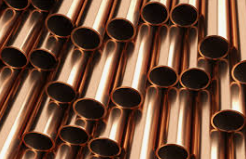Copper-Steel Composite Welding: Applications in Aerospace and Military Industries
Nov 04, 2025In the high-stakes realms of aerospace and military engineering, copper-steel composite welding has emerged as a transformative technology, enabling the creation of bimetallic materials that combine copper's superior thermal and electrical conductivity with steel's exceptional strength and durability. As of November 2025, amid escalating demands for lightweight, high-performance components in hypersonic vehicles, unmanned aerial systems (UAS), and advanced weaponry, this welding technique—often involving explosive, friction stir, or laser methods—addresses critical challenges like thermal management and structural integrity. With global defense spending surpassing USD 2.3 trillion and aerospace markets projected to reach USD 1.1 trillion by 2030, copper-steel composites are pivotal for innovations in extreme environments.
Copper-steel composite welding typically employs explosive welding, where a controlled detonation bonds copper (often oxygen-free or clad variants) to steel (like stainless or low-carbon grades) under immense pressure, forming a metallurgical interface without melting the base metals. Alternative methods include laser welding for precision joints or friction stir welding for reduced distortion. The resulting composite features a copper layer (10-30% thickness) for conductivity and corrosion resistance, bonded to a steel substrate for mechanical robustness. Key standards like AWS D17.1 govern these processes to ensure defect-free bonds, minimizing voids or intermetallic brittleness.
These composites boast thermal conductivity up to 350 W/m·K from copper, paired with steel's tensile strength exceeding 500 MPa, yielding a material with excellent heat dissipation, corrosion resistance, and fatigue endurance. Density averages 8.2-8.5 g/cm³, offering weight savings over monolithic metals. In harsh conditions, they resist oxidation and thermal cycling, with interfaces maintaining integrity at temperatures up to 500°C—ideal for aerospace and military applications where failure is not an option.
In aerospace, copper-steel welding enables heat exchangers, cooling staves, and structural components for aircraft engines and satellites. For instance, in hypersonic vehicles, composites manage extreme heat fluxes in propulsion systems, while in space exploration, they form shielding for electronics against radiation and thermal extremes. Small satellites and drones utilize copper-clad steel for antennas and electromagnetic interference (EMI) shields, enhancing signal integrity without adding weight. This supports agile platforms in reusable rockets and high-altitude UAVs.
Military applications leverage the composites' robustness for armored vehicles, missile systems, and naval hardware. In defense, they appear in radar antennas, EMI shielding for command centers, and heat sinks for directed-energy weapons. Explosive-welded copper-steel plates enhance ballistic protection in aircraft carriers and tanks, combining steel's impact resistance with copper's conductivity for integrated electronics. U.S. Army research highlights strengthened copper variants for advanced systems, improving durability in hypersonic munitions and electronic warfare tools.

Entering late 2025, the copper-steel composites market is valued at approximately USD 2.5 billion, with a CAGR of 6.8% through 2032, propelled by aerospace electrification and military modernization. Asia-Pacific leads with 45% share, driven by China's hypersonic advancements, while U.S. CHIPS Act extensions boost domestic production amid supply chain tensions. Copper prices at USD 4.60/lb reflect mining disruptions, but recycling initiatives cut costs by 70%. Challenges include geopolitical volatility, yet innovations like additive-manufactured composites enhance precision for stealth applications.
For tailored copper solutions supporting these composites, explore Dysen Industrial's offerings at https://www.dysenindustrial.com/copper-and-copper-alloys.
In conclusion, copper-steel composite welding is revolutionizing aerospace and military tech in 2025, delivering resilient materials for next-gen systems. As demands intensify, its adoption will drive safer, more efficient platforms.